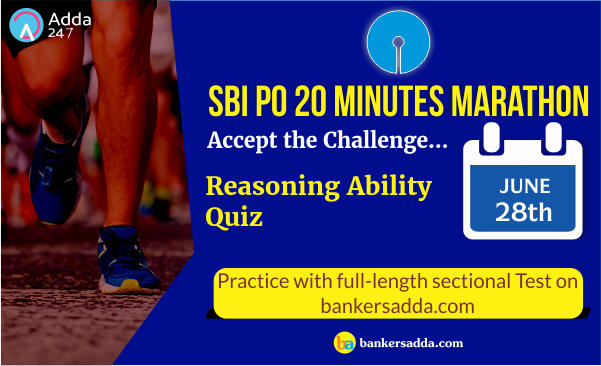Reasoning Ability Sectional Test: 28th June 2018
Bankersadda brings to you the SBI PO 20 Minutes Marathon of Reasoning Ability…its time to Chase your Success. This is a timer-based quiz of 20 minutes to help you practice for SBI PO Preliminary exam. You have already attempted the quiz of English Language and Quantitative Aptitude so keep practicing on Bankersadda. You can also take up this challenge on Adda247 App. So, start practicing for the real examination right away. This will not only ensure your success in the exam but will also help you bag maximum marks in the Reasoning Ability Section with a planned strategy.
Directions (1-5): A word and number arrangement machine when given an input line of words and numbers rearranges them following a particular rule in each step. The following is an illustration of input and rearrangement.
Input : troop 34 gold 22 84 51 land model 67 sleep.
Step I : gold troop 34 22 51 land model 67 sleep 84
Step II : land gold troop 34 22 51 model sleep 84 67
Step III : model land gold troop 34 22 sleep 84 67 51
Step IV : sleep model land gold troop 22 84 67 51 34
Step V : troop sleep model land gold 84 67 51 34 22
And step V is the last step of the arrangement.
As per the above rule followed in the above steps, find out in each of the following questions the appropriate step for the input given below;
Input: 45 kitten war 7 71 viking Broad Trail 27 alarm 94 52
Q1. How many steps would be needed to complete the arrangement?
(1-5)
1) For words arrangement- All the words are arranged in alphabetical series in descending order from left to right in each step. That means the word which comes first in alphabetical series arranges first and so on till the last word arranges.
2) For number arrangement-. The largest number arranges in first step, followed by the second largest in next step and so on till the smallest number which is arranged at the right end.
In the final step, All the number are arranged in ascending order from right to left.
Input: 45 kitten war 7 71 viking Broad Trail 27 alarm 94 52.
Step I: alarm 45 kitten war 7 71 viking Broad Trail 27 52 94.
Step II: Broad alarm 45 kitten war 7 viking Trail 27 52 94 71.
Step III: kitten Broad alarm 45 war 7 viking Trail 27 94 71 52.
Step IV: Trail kitten Broad alarm war 7 viking 27 94 71 52 45.
Step V: viking Trail kitten Broad alarm war 7 94 71 52 45 27.
Step VI: war viking Trail kitten Broad alarm 94 71 52 45 27 7.
Q2. Which Step number would be the following output?
Trail kitten Broad alarm war 7 viking 27 94 71 52 45.
Q3. Which of the following would be the step III?
Q4. In step V, which of the following word/number would be on the 6th position (from the right)?
Q5. In step V, ‘Viking ’ is related to ‘27’ and ‘Trail’ is related to ‘45’. In the same way ‘Broad’ is related to?
Directions (6-10): In the following questions, the symbols @, #, %, $ and * are used with the following meaning as illustrated below.
‘A @ B’ means ‘A is not smaller than B’
‘A # B’ means ‘A is neither smaller than nor equal to B’
‘A % B’ means ‘A is neither smaller than nor greater than B’
‘A $ B’ means ‘A is not greater than B’
‘A * B’ means ‘A is neither greater than nor equal to B’
Q6. Statements:
M % N, N $ O, O * P, K $ P
Conclusion:
I. M % O
II. O # M
II. O#M (Not True)
Q7. Statements:
C % D, E * F, A # C, D @ E
Conclusion:
I. A # E
II. D @ A
II. D @ A (Not True)
Q8. Statements:
D @ E, B # C, C % D, A # B
Conclusion:
I. C # E
II. C % E
II. C % E (Not True)
Q9. Statements:
X @ Y, V $ W, U * V, W * X
Conclusion:
I. U $ X
II. X % V
II. X % V (Not True)
Q10. Statements:
M % N, N $ O, O @ P, L * M
Conclusion:
I. M @ P
II. O # L
II. O # L (True)
Directions (11-15): Study the information and answer the given questions:
Eight employees A, B, C, D, E, F, G and H will have to take the leave in the months of January, March, July and November but not necessarily in the same order. In each month, they all will take a leave on either 8th or 19th of the given month. Not more than two employees will take a leave on the same month. Only one employee will take a leave on each day. Only one person will take a leave before the G. More than three persons will take a leave between G and A. Only one person will take a leave between A and H. Two persons will take a leave between H and B. Only one person will take a leave between B and F. Two persons will take a leave between F and C. D will take a leave one of the days after E. Neither D nor E will take a leave on 19th of the any of the given month.
Q11. Who among the following will take a leave on 8th January?
Q12. Who among following will take a leave on 8th November?
Q13. H will take a leave on which date and month?
Q14. Who among following will take a leave on March month?
Q15. How many persons will take a leave between F and E?
Directions (16-20): Each of the questions below consists of a question and two statements marked I and II given below it. You have to decide whether the data provided in the statements are sufficient to answer the question. Read both the statements and give answer.
Q16. How many sisters does S have?
I. M and T are sisters of K.
II. D is husband of B, who is mother of K and S is child of D.
Q17. Among P, Q, R, S, T and V, who is the tallest?
I. P and S are taller than Q, T and V but none of them is the tallest.
II. P is taller than S but shorter than R.
R > P/S > Q/T/V
Q18. On which date in January, Pinku celebrates his birthday?
I. Pinku’s sister correctly remember that Pinku’s birthday is in second week of January.
II. Pinku’s sister correctly remember that her birthday is on last day of second week of January month.
Q19. How is ‘iron’ written in a code language?
I. ‘iron metal more costly’ is written as ‘ho na pa da’ in that code language.
II. ‘buy more iron things’ is written as ‘na ka ta da’ in that code language.
Q20. What is Deepu’s position from the left end in a row of children?
I. There are ten children between Deepu and Rohan
II. Rohan is seventh from the left end of the row of children.
Directions (21-25): Study the following information carefully and answer the questions given below:
Eight persons P, Q, R, S, T, U, V and W are sitting around a circular table facing towards the centre of the table. Each of them has wear different brand cloths viz. Zara, Levis, Adidas, Rebook, Raymond, Mufti, Woodland, Richlook, but not necessarily in the same order.
The one who wear Zara brand sits on the immediate left of the one who wear Richlook brand. The one who wear Woodland brand does not sit immediate left of U. V and T are not immediate neighbours. V, who does not wear Raymond brand, sits on the immediate right of W. P sits second to the right of the one who wear Woodland brand. S wear neither Mufti nor Woodland brand. There are two persons sitting between R and the one who wear Mufti brand. There is only one person sits between one who wear Mufti brand and the one who wear Richlook brand. T and Q are immediate neighbours. The one who wear Raymond brand sits second to the right of U. W wears neither Zara brand nor Levis brand but he is an immediate neighbor of the one who wear Raymond brand. The one who wear Zara brand does not sit adjacent to one who wear Rebook brand. P and R, who wear Adidas brand, can never sit adjacent to each other. There are two persons sit between the one who wear Woodland brand and the one who wear Raymond brand.
Q21. What is the position of W with respect to the one who wear Mufti brand?
Q22. How many persons are there between R and T, when counted from left of R?
Q23. Who among the following sits second to the left of the one who sits opposite the one who wear Levis brand ?
Q24. Who among the following sits third to the right of S?
Q25. What is the position of P with respect to V?
Directions (26-30): Study the following information to answer the given questions:
In a certain code,
“its all about for” is written as ‘N6R N1T Q1L I9S ’
“among success necessary works” is written as’K23S J14Y Z19S N1G’
“who tells you the” is written as ‘U23O Q20S U20E N25U’
Q26.What is the code for ‘light’ in the given code language?
(26-30)
Q27.What is the code for ‘proximity' in the given code language?
Q28.What may be the possible code for ‘methods’ in the given code language?
Q29.What may be the possible code for ‘fifth stifled’ in the given code language?
Q30.What is the code for ‘Selection' in the given code language?
Directions (31-35): Study the information and answer the given questions:
Seven people P, Q, R, S, T, U and V live on separate floors of a 7-floor building. Ground floor is numbered 1, first floor is numbered 2 and so on until the topmost floor is numbered 7. Each one of them belongs to different state, viz UP, Assam, Bihar, Punjab, Goa, Manipur and Nagaland but not necessarily in the same order. Only three people live above the floor on which P lives. Only one person lives between P and the one belongs to Manipur. U lives immediately below the one who belongs to Assam. The one belongs to Assam lives on an even-numbered floor. Only three people live between the ones belongs to Manipur and Bihar. T lives immediately above R. T does not belong to Bihar. Only two people live between Q and the one who belongs to Goa. The one who belongs to Goa lives below the floor on which Q lives. The one who belongs to UP does not live immediately above or immediately below Q. S does not live immediately above or immediately below P. V does not belong to Punjab.
Q31. Which of the following is true with respect to V as per the given information?
Q32. Who among the following lives on floor no. 3?
Q33. Who lives on the floor immediately above T?
Q34. S belongs to which of the following states?
Q35. How many people live between the floors on which S and the one who belongs to Assam live?
- IBPS RRB Notification Out: Check Official Notification
- Stand Your Ground Till You Do Not Make It Happen
- Syllabus for IBPS RRB 2018 Exam
- IBPS RRB 2018 Preparation Strategy: Get Started!




 The Hindu Review October 2022: Download ...
The Hindu Review October 2022: Download ...
 RBI Assistant Syllabus 2024 and Exam Pat...
RBI Assistant Syllabus 2024 and Exam Pat...
 Employment News 2024, Download Weekly PD...
Employment News 2024, Download Weekly PD...



